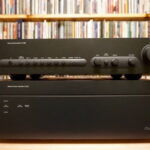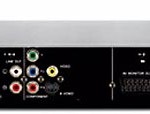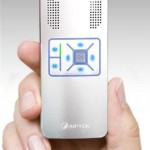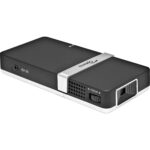Introduction
Pioneer has had a long history of producing exceptionally high-quality audio and video products, especially in their cutting-edge Elite line. Their plasma display HDTVs for example, have consistently displayed sparkling images in recent years, handling all types of content. Currently, the company offers what is considered by many to be the best plasma TVs on the market today (especially in the 50-inch category). Pioneer was also the creator of laserdisc technology – the first optical disc playback system years ago, which was the forerunner of the Digital Versatile Disc, or DVD as we know it today. On the audio side, Pioneer products have been top-rated in several consumer and A/V magazines over the years, including such prestigious publications as Consumer Reports, ELECTRONIC HOUSE, Home Theater magazines, and, of course, Digital Trends online. The bottom line: Pioneer has always been on “the edge of the envelope” of aural and visual technological innovations. For this write-up, I am reviewing their Elite VSX-84TXSi A/V Receiver and using their PD-5070 plasma HDTV as the display device of choice.

The Pioneer Elite VSX-84TXSi is the company’s current, top-of-the-line
A/V receiver, priced at $1,500 USD. It includes HDMI and i.LINK
(IEEE1394) switching capability. This receiver offers several visual
and aural enhancements and refinements, including Faroudja DCDI video
processing along with integrated THX Select 2, Dolby Digital, and
several modes of DTS-ES processing. Therefore, it is one of the best
examples of an A/V receiver available.
Features and Design
7.36” H x 16.54” W x 18.35” D), the VSX-84TXSi is certainly a force to
be reckoned with. Audio power is rated at 140 watts per channel for all
seven built-in amplifiers. The VSX-84TXSi includes a digital tuner with
30 station presets and is XM-ready with on-screen display,
HD-Radio-ready, and iPod dock-ready. It also includes one rear panel AC accessory outlet for the attachment of another piece of A/V gear.
converter as well as the Shark-EX + 48-bit Freescale DSP. It also
features Sanding Wave and X-Curve Control. The receiver includes Dolby
Digital EX, DTS-ES, Dolby Pro Logic II (movie & music), WMA-9
Decoders, and features advanced concert and cinema surround (12 modes).
It also includes THX Select 2 processing and certification. This receiver
allows your speakers to reach their full potential, so the audio output
of the VSX-84TXSi is nothing short of spectacular! In either the
Standard (surround) or Stereo modes, you can reduce extraneous noise by
using the Digital NR (noise reduction) function button.
Video Conversion that converts S-Video, Composite, and Component Video
up to HDMI. A Faroudja DCDi HD video scaler upconverts lower resolution
signals up to 480p, 720p, or 1080i. There's also analog video parameter
processing.{mospagebreak}
Connections:
It is certainly a connection powerhouse to be reckoned with as well. This model includes 4 HDMI inputs, 3 component video (HDTV-level 100Mhz+) inputs, 4 S-Video inputs, 7 digital inputs, dual i.LINK Digital Audio inputs, and one USB input for PC Audio.

Like all upscale A/V receivers today, this model includes front A/V/S-Video jacks + digital optical in for easy attachment of a camcorder (for playback and dubbing) or a video game console. Outputs include 2 A/V/S-Video outs, one component video out, one HDMI out, one subwoofer out, and 2 digital optical outputs as well. All input and output terminals are gold-plated for the best possible signal contact, and all speaker terminals utilize binding posts for the best connectivity possible.
Like some of its competitors today, this model also includes HDMI and component video switching, but this is where the similarity ends. Upconversion is the capability to upconvert composite video and S-video signals to component video or HDMI level. This allows for easier video switching between different video sources. In simplified terms, this means that all A/V switching can be accomplished within the receiver, and there is only one HDMI cable tethered to your display monitor – in this case, the PD-5070. In the past, if you wanted to change video sources, you might have had to change video inputs on your television (from Video 1, Video 2, etc.), which became cumbersome after awhile. Now, there’s one connection for all video signals, which makes it easier and much simpler to use. Also, the composite and S-Video signals are upconverted internally, offering the highest resolution possible (thanks to the Faroudja video processor) from those sources, such as an aging VCR or cable box. Lastly, there's also an RS-232 connector and an iPod input terminal via an optional iPod control cable.
straightforward, and relatively easy to use. Just let your fingers do
the walking from the remote control. An added convenience feature found
on the 84TXSi is the Multi-Channel Acoustic Calibration Circuit
(or MCACC for short). Simply plug in the supplied calibration mic, and
at the touch of a button the system will calibrate itself based on your
room’s acoustics. Of course, you can tune and tweak it manually, but
it’s far easier and more accurate (since most of us don’t have “golden
ears”) to use the supplied MCACC accessory.
 Remote Control:
Remote Control:
A/V Receiver used a touchscreen remote, but to keep prices down, a new
remote is now employed. This 64-button remote is laid out in the
standard fashion. I do have to say, however, that it is a far cry from
the previous touchscreen. It features a tiny LCD screen at the top of
the remote to remind you of what component you are recording. Directly
below the LCD screen are 8 device buttons ranging from DVD to Receiver.
To control additional components, you need to press the "Shift" button
in the lower right-hand corner of the remote and press the “Video 1”
button to access Video 2, for example. It’s a little cumbersome.
cursor arrow keys located in the center of the remote. There's also
dedicated TV control buttons below the cursor keys. The TV control keys
are followed by a set of keys that will control a Satellite STB, DVD, or DVR.
The bottom section of the remote includes keys dedicated to surround
sound processing. While the remote is full-featured, it's not
illuminated, and the gray keys with white lettering a on a black
background are not the easiest to use. A smaller second remote is also
included for second-room use.{mospagebreak}
Even though I'm not a big fan of the remote, I've had worse. What's important here, however, is how the VSX-84TXSi performs, and in that department, it performs admirably. Also, the fact that you can hook up 4 – I repeat, 4 – HDMI-enabled devices is a godsend today as more and more products now utilize HDMI. Currently, I have an EchoStar ViP-622 HDTV Satellite Receiver with DVR, Sony Playstation 3, Toshiba HD-XA2, and an Oppo Digital DV-981HD upconverting DVD player attached to the receiver. In turn, the VSX-84TXSi is tethered to the Pioneer PD-5070. The receiver allows you to pass-thru the video signal directly to your display without processing (including 1080p), or you can utilize the internal Faroudja DCDi HD video scaler that converts lower resolution video signals up to 480p, 720p, or 1080i. Obviously, the audio is processed directly inside the receiver.
One of the best things about this receiver is that it includes auto-sensing circuitry, which means that it detects the type of incoming signal being sent, and automatically switches to that particular processor (e.g. Dolby Digital, DTS, or Pro Logic II). A display on the front panel of the unit lights up and gives you visual notification of DTS-ES (or SACD, or whatever). You don’t have to worry about changing anything. Auto-sensing is also carried to its logical conclusion via the i.LINK connection as well. Once you plug in the IEEE1394 cables, the 84TXSi and the i.LINK-enabled device “shake hands” and recognize/enable each component to utilize their i.LINK connectors. This is especially helpful for universal DVD players that play back both DVD-Audio and SACDs.
There was one HDMI video cable (Monster Cable) tethered to the PD-5070 from the VSX-84TXSi passing all video signals. The images displayed upon this plasma display were simply spectacular from HD sources such as CBS, ABC, HBO, and ShowTime, as well as the Blu-ray Disc and HD DVD sources. Normal HD satellite images from EchoStar didn’t look too shabby either. The Toshiba HD-XA2 is a serious HD DVD player, and all of the images displayed on the 5070 had clarity and depth of field, giving the illusion of true HD quality from a HD DVD player. If you want to be a stickler, you can always put on the Video Essentials test disc – or use the Home Theater Demo disc featuring Mannheim Steamroller – and watch test patterns, measure gray scale (which I did), and calibrate and test different multi-channel audio signals. But the proof is in the pudding, so to speak, and let’s face it, a DVD player and an HD Monitor are designed to watch movies and music videos – not test patterns.
Pioneer VSX-84TXSi RemoteThanks to its powerful, 140-watts per channel x 7 @ 8 ohms amplifiers, the 84TXSi “Direct Energy” amplification powerhouse delivers serious horsepower at all sound levels. By employing THX Select2 certification, it provides a sonic framework capable of producing sound levels of 115dB or higher (e.g. a jet taking off is 120 Db) without taxing the system. While other receivers might produce harsh or raw noise at these levels, the 84TXSi produces a warm sound to complement and enhance the other components in the system. In other words, the 84TXSi was never aurally taxed at any sound level. Also, to handle the wide frequency range of DVD-Audio, the 84TXSi covers a frequency range of 20Hz to 20kHz. In turn, by using a copper direct-current bus bar, diode, and transistor covers, the electrical current output is consistently stable across all 7 channels of power, which is critical in aural reproduction from Dolby Digital EX, DTS-ES, or PCM movie soundtracks to the musicality of SACD or DVD-Audio discs.
But… “How did it sound? Was it musical enough?” is a question my audio friends always ask. My family room measures 13 feet by 20 feet and can accommodate a large-screen TV and support seven B&W speakers. I am literally surrounded by sound. The B&W's certainly cocooned me and enveloped me in a 360-degree soundfield, which is the goal of 6.1 and 7.1 surround sound sources. Films sounded especially realistic, lifelike, and natural through the B&W loudspeakers from all TV and movie sources. New Line’s Blade II DTS-ES 96/24 6.1 soundtrack, for example, sounded especially realistic during the subterranean tunnel sequences of chapters 15 – 17 that give a new meaning to “you are there,” as music, effects, and dialogue emanate from all directions around you. While Revolutionary Studio’s Black Hawk Down is certainly visually harrowing, it also makes you duck and take cover as bullets whiz all around you.
These are just two examples of many films that sounded sonically superior, thanks to the 84TXSi’s surround processing and B&W’s accurate aural imaging (and I can’t forget to mention the superior imagery of the Toshiba HD-XA2 HD DVD player and Pioneer's PD-5070 plasma HDTV). It should be noted that even older films with a new Dolby Digital 5.1 soundtrack – like Columbia’s 1776: Restored Director’s Cut – sounded especially crisp and clear. In fact, this newly restored film never looked or sounded as good (even on laserdisc) as it does on this pressing. The DVD is so much better than what appeared originally years ago in theaters, bringing back the joys of the original Broadway theatrical production.
With both the DVD-A and SACD recordings, the discs came to life vibrantly, giving the listener the illusion of sitting in the audience for the artist’s performance. With different instruments being directed to somewhere other than the front two speakers, it gives the illusion of being in the center of the music, and that’s not a bad feeling. Personally, I prefer multi-channel sound for today’s recordings, but that’s just me. If you asked me which music system sounds better, I would say that it’s hard to tell. Personally, I think they’re both great compared to the cold and sterile CD! With an HD DVD player or the Oppo Digital “universal” player, you don’t have to chose one format over another and can sit back and enjoy the best of both formats. Within the various DVD-A recordings there's the Ambience Series: Summer Song by Mannheim Steamroller, in which there is a summer rainstorm; I really got the feeling that I was in the middle of that rainstorm, and I quickly sought out an umbrella. On the SACD flip side, Abkco’s Rolling Stones Remastered brought me back to the Sixties again – all I needed were my rose-colored glasses and something to inhale. In fact, The Stones never sounded so good (as they did on SACD), meaning that the recordings truly sounded edgy and raw – something missed on standard CD pressing and vinyl as well – but not metallic or harsh-sounding to the ear. It's unfortunate that these two next-generation audio formats have fallen to the wayside.{mospagebreak}
all-around performer. It worked extremely well, and all sound sources
sounded terrific. I'm a firm believer in using A/V receivers for all
switching and aural processing. The A/V receiver is really the heart
and soul of a true home theater system and the 84TXSi does not
disappoint. So, if you're in the market for an A/V Receiver that will
become the central focus of your home theater system, the 84TXSi is the
perfect choice. While I wish that Pioneer would have kept the
touchscreen remote used with previous receivers, it would have added
another $500 USD to the price of the receiver. And, the fact that this
receiver includes 4 HDMI inputs is truly impressive!
4 HDMI inputs
1080p pass-thru
Poorly-designed primary remote
Slightly cumbersome setup
Specs
Power and Sound:
140 Watts x 7 Direct Energy Amplification (20Hz – 20kHz, 8 ohms, .09% THD – FTC)
Stream Direct Mode
Air Studios Sound Tuning
Rigid Trans Stabilizer Construction
Audio:
New Sharc-EX + 48-bit Freescale DSP
Advanced MCACC with 9 Band EQ & Phase Control
Standing Wave & X-Curve Control
Sound Retriever for Portable and XM Radio
192 kHz / 24-Bit Audio Digital to Analog Conversion
THX™ Select 2 Processing & Certification
Dolby Digital® EX, DTS-ES, DTS 96/24, & WMA-9 Decoders
Neural Surround for XM-HD Radio
Advanced Concert and Cinema Surround (12 Modes)
Digital Noise Reduction
Video:
Digital Video Conversion Up to HDMI
HD Video Scaling to 1080i or 720p
Analog Video Parameter Processing
Connectivity:
4 HDMI Inputs / 1 HDMI Output – 1080p / DVD-A Compatible
iPod® Audio, Photo, and Video Connection – Cable Included
XM®-Ready with On-Screen Display
Dual i.LINK Digital Audio Interface with Jitter-Free PQLS
3 Component Video Inputs / 1 Component Video Output
4 S-Video Inputs / 2 S-Video Outputs
7 Digital Inputs / 2 Digital Outputs (optical)
2 Composite Video Outputs
Phono Input
USB Input for PC Audio
Custom Features:
On-Screen Display
3 Zone Multi-Room & Source (Analog A/V Out for Zone 2 /
Digital Audio Out for Zone 3)
RS232C Interface
Dual 12 Volt Triggers with 2nd / 3rd Zone Assignment for Each Function
Dual I/R Inputs
Assignable Surround-Back Speaker for Multi-Room and Bi-Amp
Main Room / Multi-Room Remote Control for Zone 2 and Zone 3
LCD Preset / Learning Remote with Preset
Multi-Operation
Secondary Main Room Remote with iPod and XM Control and Audio Sgnals,
Including: DVD-Video, DVD-Audio, Dolby Digital®, DTS® Digital Surround,
and More.
Dual i.LINK Outputs – Single Wire Connection Providing Jitter-Free
Multi-Channel High Resolution Audio, Including: DVD-Audio, SACD, Dolby
Digital®, DTS® Digital Surround, and More.
Product Dimensions:
W x H X D: 16.54” x 7.36” x 18.35”
Weight: 35.3 lbs.
Inputs/Outputs:
4 HDMI Inputs/1 HDMI Output for HDTV/5.1/DVD Audio and Video/
Digital Video Conversion to HDMI
2 i.LINK Advanced Resolution Digital Audio Inputs for DVD-Audio,
SACD, 5.1 and Stereo Audio Signals
SR+ Plasma Control/Custom IR/Multi-Room A/V Output/
Multi-Room Digital Out/12-Volt Trigger
6 Composite A/V and 4 S-Video Inputs for Cable TV/Satellite/VCR/
DVD-Player/DVD-Recorder/Game Console
XM® Connect-and-Play™ Antenna Receiver/Audio/
On-Screen Menus
3 Component Video Inputs for HD Video Sources – Cable/ Set-Top
Box/Game Console/Digital Video Conversion
7 Assignable Digital Inputs for DVD Player/Recorder/Satellite/
Cable/Game Console 5.1 Audio; 2 Assignable Digital Outputs with
Multi-Room Option
IR Control/RS-232c for Advanced MCACC Room Calibration and
Custom Control Systems/USB Input** for PC Audio
Ready for iPod Audio, Photo, and Video/On-Screen Menus/Charger
Assignable Surround Back Speaker Output for Zone 2,
Bi-Amp, Multi-Room/Mulit-Source Options






